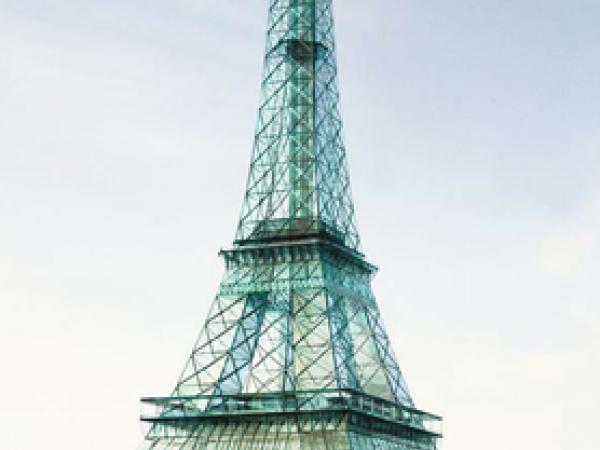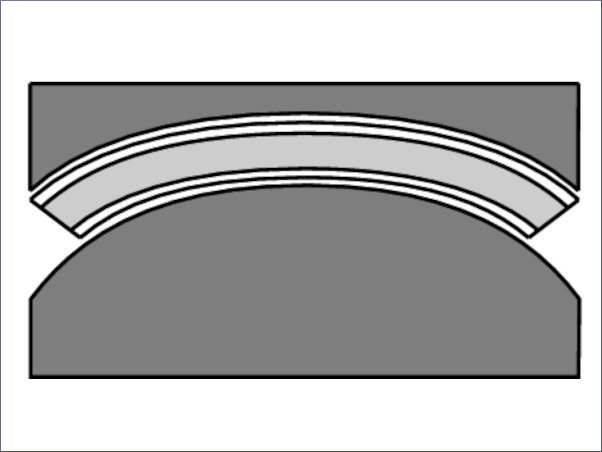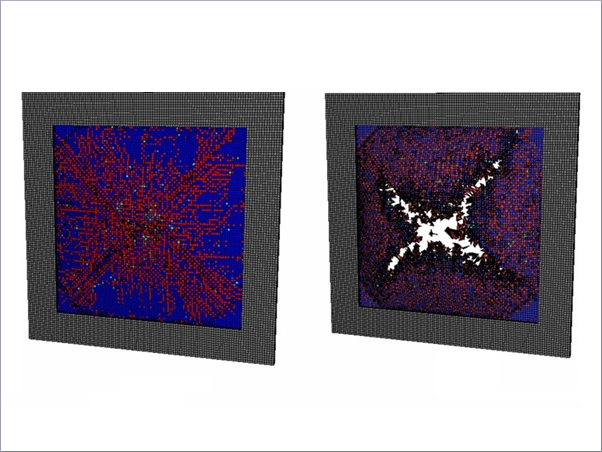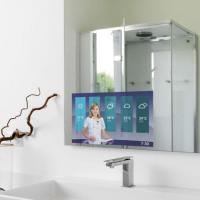In recent years, not only have architects discovered laminated safety glass as a building material, but they have also learnt to better exploit its exceptional structural and design performance. Now, DuPont™ SentryGlas® interlayers with increased stiffness combine cost-efficiency with high performance, thereby significantly widening the scope of application for this building material – from private houses to luxury villas, skyscrapers and manufacturing facilities and cultural landmarks.
For centuries, the use of glass in construction has been to meet three principal requirements: to let in daylight, to grant a direct view of the immediate surroundings and, at the same time, to provide protection against the elements. Glass manufacturers have perfected these properties over time. A significant improvement in relation to all three aspects was achieved with the introduction of laminated safety glass (LSG). The extent of these improvements is still difficult to determine today, several decades later, because architects and structural planners are using only a fraction of its potential performance – mainly due to the lack of relevant information, as a result of instilled preconceptions, or because the required legal conditions are yet to be defined. As a consequence, over-sizing is commonplace, using structures which are greater, heavier and therefore more expensive than their purpose requires.
SentryGlas® expands the horizon
Despite many years of usage, traditional single-pane safety glass (SPSG) still carries the risk of sudden failure, caused by nickelsulfide inclusions, and with it the potential for a highly dangerous shower of glass fragments. LSG behaves completely differently, because two or more flat glass panels are laminated together using a polymer interlayer, which adheres securely to the glass.

A highly transparent laminate is created, resistant to the forces of nature, vandalism, blasts and other security risks. In the event of it breaking, glass fragments remain stuck to the interlayer, instead of falling off and becoming hazardous projectiles, endangering people and damaging equipment or furniture. It is for this reason that LSG is the only form of glazing permitted for overhead glazing and glazings with additional post glass-breakage performance requirements. In 95 % of cases, interlayers made from polyvinyl butyral (PVB, e.g. DuPont™ Butacite®) are currently used. However, the new DuPont™ SentryGlas® interlayers are gaining in market share.
This new interlayer, originally developed for glazing in hurricane-zones, is considerably stiffer than PVB. As a result, the laminate can either bear greater loads or – at the same load – can be reduced in width without compromising safety. This creates new and interesting perspectives for architects, and almost boundless freedom of design, because the processing properties of the new interlayers enable the production of theoretically limitless sizes of glass – as long as they fit within the available autoclaves. The largest glass element to be produced to date measures 3 m in width and 13.5 m in length. The combination of durable, crystal-clear transparency, almost limitless protection against yellowing and its excellent edge stability under extreme weather conditions make SentryGlas® even more appealing for interior and exterior architectural installations.
Hundredfold stiffness
If two sheets of glass, lying on top of each other, are placed under load, they will start to bend independently. Displacement occurs between the two inner surfaces, which are in direct contact with each other, because one of the two surfaces is being stretched while the other is being compressed.
.jpg)
Should both sheets be laminated with an adhesive polymer interlayer, this must be able to internally compensate for the distortional differences. In other words, it must be able to absorb shear forces (fig. 1). PVB interlayers such as DuPont Butacite® do this effectively when exposed to temporary, sudden loads. Hence, laminated safety glass produced with such an interlayer provides excellent protection against the effects of vandalism, hurricanes or explosions, for example. However, PVB is a soft polymer, which starts to creep under long-term loads.
.jpg)
The consequence: two glass sheets laminated together using PVB, and exposed to a long-term flexural load, behave in just the same way as two sheets which have not been joined together. Therefore, static calculations to date only consider the properties of the glass components, and not of the overall LSG laminate coupling effect. SentryGlas® interlayers react quite differently. Their strength during tensile testing is considerably higher than that of PVB, and their stiffness at room temperature is actually one hundred times greater (fig. 2). Behavior at increased temperatures is also improved (fig. 3).

Thinner laminates, higher safety
The change in constraints compared with PVB makes it logical to reconsider the approach when designing statically-loaded laminated glass panels, and to also account for the mechanical properties of the interlayer. Corresponding approaches are available from DuPont.

The potential opportunities are illustrated by externally-conducted testing on glazing for balustrades [1], whereby a monolithic sheet (19 mm tempered SPSG) was compared to two LSG laminates (10 mm tempered / 1.52 mm PVB / 10 mm tempered and 10 mm tempered / 1.52 mm SentryGlas® / 10 mm tempered). The glass panels, measuring approximately 1,200 mm by 1,200 mm, were fixed at the bottom. In a first test a linear load (1.5 kN/m) was applied at the upper edge of the glass panels (opposite to the fixing). In two further runs, a point loading (1.5 kN) was exerted at their center and on one of their outer corners respectively. Their distortional behavior, in other words the deflection of the upper edge, was measured at room temperature.

The results of all three sets of tests consistently showed that the rate of deflection of laminated safety glass with SentryGlas® was less than half of that with the PVB interlayer, and that this rate of deflection is similar to, or even less than, that recorded with the monolithic sheet (fig. 4). Mechanical tension accumulated in the glass was correspondingly lower. The following may be concluded from the above and subsequent testing: The stiffness of SentryGlas® is so high, that there is an almost perfect transfer of load between the glass sheets. This applies to a wide temperature range and also under long-term conditions. In such a manner, SentryGlas® makes it possible to produce high load-bearing laminates with an exceptional performance/weight ratio. In comparison with laminates with PVB, there are substantial opportunities for:
- glass width reduction, often in the region of one to two standard glass widths,
- the installation of larger panels at determined loads, or
- a reduction in the number of fixing points for frameless glazing.
For the user, this enables on the one hand a certain reduction in costs, on the other a reduction in the overall weight of the glazing, which is particularly desirable for moving objects such as yachts or rolling stock.

The benefits of SentryGlas® interlayers with regard to impact resistance are shown in fig. 5. Laminates, each consisting of two glass sheets with interlayers made of PVB and SentryGlas® respectively, were exposed to a series of impacts at –12 °C. The tests began with 25 impacts of 4,300 N, followed by 10 impacts of 8,600 N. Both laminates withstood the initial testing without breakage. The laminate with PVB went on to fail at a second impact of 12,900 N. The laminate with SentryGlas® withstood a further 10 impacts at this level, and only failed at a third impact of 17,200 N.
More post-breakage safety
LSG for architectural applications is the only safety glazing with optical quality which remains intact after breakage. Following a sufficiently strong impact the glass will break, yet the dangerous fragments of glass will remain adhered to the interlayer. As a result, the risk of injury to passers-by is significantly reduced and, at the same time, some of the protective benefits of the glazing against wind and rain are retained.


Comparative measurements demonstrate that this positive aspect is considerably more pronounced in laminates with SentryGlas® than those with PVB (fig. 6). During testing, both laminates were loaded with 3,300 N and then the glass was fractured with the load remaining. The deformation (displacement of the center) was recorded over time. Deformation of the PVB laminate was much greater compared with the SentryGlas® laminate. Moreover, the PVB laminate tore after approximately 7 minutes whereas the SentryGlas® laminate remained intact.
Excellent weathering resistance
Compared with standard interlayers, SentryGlas® is also more resistant to moisture and the effects of weather at temperatures between –30 °C and +70 °C. These are the consistent findings of laboratory tests and research in real-life projects. The edges of laminated glass panels used to be covered in order to hide potential damage caused by the elements.

Thanks to the exceptional edge stability of SentryGlas® interlayer, no undesired changes such as delamination have been found to date on any of its applications, even on panels with open edges that have been exposed to the hot and humid climate of Florida for seven years.

When used in combination with standard silicon sealing material, butt-joined glass elements with SentryGlas® interlayers show no discoloration or other forms of damage to their edges, even after years of weathering. Safety glazing with SentryGlas® interlayers is used externally in applications around the globe. Years later they provide the same level of safety, and feature the same intact edging, as they did when they were first installed.
Maximum transparency over many years
As well as their high stiffness, SentryGlas® interlayers provide an additional benefit: they enable highly transparent glazing. After years of usage, the interlayer retains its original transparency. Its yellowing value is 1.5 or lower, and does not increase significantly. Standard interlayers have yellowing values of between 6 and 12.

In addition, laminates with SentryGlas® do not require adhesives, other laminating aids or plasticizers, which could be a source of discoloration.
Universal application
Thanks to the excellent optical properties of SentryGlas® interlayers, architects and designers are now able to specify highly-transparent safety glazing made from low-iron glass. Among the vast number of applications possible are:
- Offices and public buildings allowing more daylight
- Display windows for department stores and retail outlets
- Security glazing for jewelry display boxes
- Panoramic windows
- Skylights and other forms of overhead glazing
- Transparent high-security glazing
- Glazing for greenhouses and sheds
- Neutrally-colored windows for art and photo studios
Architects and building engineers, who want to make the most of the specific benefits of SentryGlas®, can find laminators around the world who specialize in the manufacture of high performance laminated glass. The laminating process is almost identical to that used for standard laminated glass. Differences can be found in how the interlayers are delivered (sheets instead of rolls) and the fact that they do not need to be kept in cooled storage. SentryGlas® can be processed on existing units and production lines.
.jpg)
by Dipl.-Ing. Ingo Stelzer, DuPont Deutschland, Neu-Isenburg/Germany
Literature
[1] John Colvin, JCGC Ltd.: Comparison of Monolithic and Laminated Glass; Glass Performance Days 2007, Tampere/Finland, Conference Proceedings, Pages 648 - 649, www.gpd.fi

























